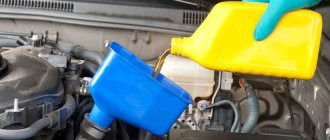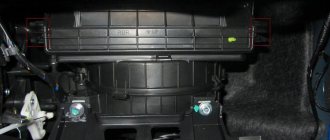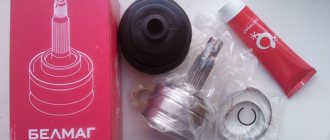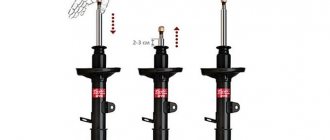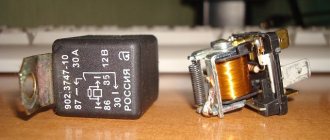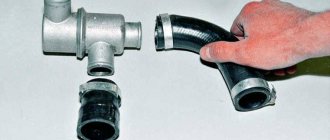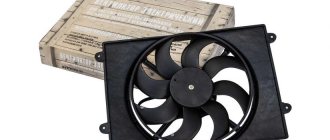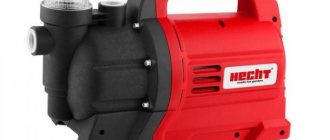Oil heating radiators are heaters with special oil and a heating element placed inside them. Such devices have several segments and are similar in appearance to standard batteries. To date, the maximum number of sections in household heaters is 14. The more such separate tanks, the more efficiently the heat is removed, and the less the body itself heats up.
Floor-standing - standard type of oil radiator
Operating principle of oil heaters
The device works on the following principle: a built-in heating element heats a vessel with mineral oil poured into a special cavity in the radiator. The oil heats up evenly, and its heat increases the temperature of the metal body - the radiator begins to heat the air in the room. The design is sealed, the device is equipped with thermostats that prevent the oil from boiling: when a certain temperature in the tank is reached, the device turns off for a while, then resumes operation. Also, when the pressure rises critically, some of the spirals close, and some of the oil is discharged into an unheated reservoir.
Important! It is necessary to ensure that the device standing on the floor does not tip over: this will disrupt the circulation of mineral oil, which can damage the heater.
When purchasing an oil heating radiator with a thermostat, you should pay attention to the characteristics of convection channels, which accelerate air circulation, increasing the efficiency of the heater. The general operating principle of such a device makes it stand out from a number of other heating and climate control devices, making it as convenient as possible for use at home.
Let's start installation
What do we need for this? In addition to the heat exchanger itself, it is worth purchasing fasteners and oil-resistant reinforced hoses 1.5 meters long.
We also need an oil thermostat. We need it so that the liquid does not become supercooled in winter. The oil in the automatic transmission should operate at a temperature of 75 to 90 degrees Celsius. Anything below or above these values is unacceptable. Please note that when installing an additional automatic transmission oil cooler (whether it is universal or not does not matter), it is worth including a thermostat in the circuit. It will block cold oil flows. This way, the fluid will warm up to operating temperatures faster in winter, and you will drive a functional, warm box.
Let's look at the installation features using the example of a Subaru Forester car. So, first we need to decide on the installation diagram. Experienced motorists do not recommend installing an additional heat exchanger in the intake line of the factory cooler. This solution is useless, since at the outlet of the factory radiator we will get hot ATP fluid heated to 95-100 degrees. But how to install it? The most correct option is to install the element in the return line, which is located on the way from the factory radiator to the automatic transmission.
Having understood the installation diagram, we proceed to dismantling the body cladding. First you need to remove the driver's side headlight and bumper. Next, you should remove the tube from the expansion tank and remove the fastenings of the main radiator. It is installed on the front panel.
Since we also have an air conditioner radiator nearby, we cannot allow both coolers to be next to each other. To do this, we use 3 mm spacers and glue Teflon plates onto the fastening elements of the additional automatic transmission radiator. During installation, the element may be skewed. To avoid this, it is necessary to trim the plastic clips of the ties. During installation, the latter must pass through the honeycombs of the air conditioner cooler and the standard heat exchanger. At the exit, the ties are fixed with a cap. Such fastening is carried out at four points.
But the installation of an automatic transmission oil cooler does not end there. Next you need to remove the radiator tank. It is secured with two bolts. Then unscrew the three screws securing the fan plate. This will give us free space to tighten the caps from inside the radiator. On the right side of the bumper we see two oil lines. We need a return. It is easy to recognize - it is located further from the “stern”. When removing the pipe, be prepared for ATP fluid to splash. It is better to plug it with a homemade plug or place a clean container under the hose. Next we connect the oil thermostat. It is not necessary to drill the fasteners - just secure it to two construction ties.
Oil Based Heater Options
There are the following types of oil radiators:
- Floor-standing. The standard type of heater can be mobile or stationary, depending on the number of sections, it is used both for home use and for heating large office premises.
- Wall-mounted. A more economical model with less electricity consumption. Most often, such devices are used in offices due to their immobility and heavy weight.
- "Warm baseboard." The heater got its name due to the fact that the sections have a reduced size, but at the same time their total number has been increased so that the device can be conveniently positioned along the wall.
- Heater with fireplace effect. Its body has additional holes that accelerate air circulation.
Modern models are safe and can be used in any room
Floor heaters have gained the most popularity as they are the most convenient for heating a home. They are easy to move around the apartment (when purchasing, make sure that the model is equipped with wheels and a holder), depending on the number of oil tanks, they can be used to warm up one room or several rooms at once.
Wall-mounted models are most often purchased for offices: they, as a rule, contain more sections, but are characterized by low energy consumption and literally do not “get in the way” underfoot. The warm baseboard system is most often used if the apartment has a particularly cold floor, in rooms where there may be a draft, etc. Their power is significantly lower compared to classic floor models. At the same time, a radiator with a fireplace effect can be either floor- or wall-mounted; this system is increasingly used in the development of new lines of climate control equipment.
Important technical features of an oil heating radiator
All of these heaters may differ in power, so when choosing a radiator for your home, you should take into account the area of the room to be heated. To heat 10 sq. m will require 1 kW of energy (if this is a room with a standard height of 2.75 m).
Wall-mounted oil radiators - more economical models
In the description of the device, you should pay attention to the following characteristics:
- power. Oil radiators are characterized by a range of 0.5-3.0 kW, but even high-power devices cannot replace central heating;
- protection from moisture. This parameter is displayed with special markings: IP20 - no protection, IP24 - protection against splashing water, IP21 - protection against drops;
- thermal insulation coefficient: up to 0.9 - device for insulated houses, up to 2 - for standard rooms, up to 3 - for houses with single brickwork, up to 4 - for wooden houses and buildings without thermal insulation.
Mobile heaters can be used to warm up several rooms; they are safe to install in children’s rooms - the body heats up weakly (average temperature is about 60 degrees) and cannot burn.
Important! The distance between the heater and flammable objects must be greater than 90 cm.
Heater with clothes dryer
Many radiators can operate in several user-adjustable modes. They are quite safe and can be left to work unattended. There are devices equipped with air humidifiers, remote controls, and electronic timers. These functions simplify the use of the device, but also significantly affect its cost.
Leading manufacturers of electric heaters
Leading manufacturers of electric heaters
Oil heating radiators are universal. They can be used to heat an office space, cottage or apartment, providing optimal conditions and a comfortable microclimate. Manufacturers offer a variety of models of such heaters, but according to customer reviews, the best are the following:
- Vitek - inexpensive radiators with thermal control function and overheating protection. Such radiators can operate at sub-zero temperatures down to -10 degrees, the price of the device is affordable;
- Rolsen produces budget models used as an additional means of heating; the products of this company have protection against overheating when the device is tipped over, the protection class is high;
- DeLonghi offers equipment with excellent performance properties, quick access to operating power, which allows for more economical energy consumption (the cost is higher than that of budget models, but the quality of this manufacturer’s products is much higher);
- NeoClima produces battery-type radiators designed for floor installation (the heaters can be used for summer cottages, or they can be left indoors in the winter);
- Erisson offers convenient wall-mounted radiators equipped with temperature controllers and control units (devices of this type are ideal for small spaces, allowing efficient use of the surrounding space);
- Electrolux offers the best equipment in various price categories; radiators are equipped with mechanical or electronic control units, protective relays, and additional fans to enhance convection flows.
When choosing a heater, you need to take into account not only the brand and price, but also the presence of some special functions. For example, for a summer residence it is better to take radiators from DeLonghi, which have an oil antifreeze function. Such equipment can be safely left at the dacha in winter without fear that the oil will freeze and the system will fail.
How much better is an oil heater than an electric one? The main difference is that oil devices are used for additional heating, and not the main one. Without proper maintenance, they can cause constant burning of dust and the air becomes dry. Therefore, it is best to use heaters as an auxiliary heating system for summer houses, offices or country houses, unheated utility rooms and warehouses.
Advantages and disadvantages of using oil-based appliances
Oil radiators have many advantages over other heaters:
- during operation they do not absorb oxygen - they do not dry out the air in the room;
- They operate silently and do not emit any foreign odors;
- mobile and relatively small in size;
- affordability: different oil radiators have different prices; you can find both expensive and budget devices. The average cost varies from 1.5 to 10 thousand rubles.
- the tightness of the vessel with oil, static stability and moderate energy consumption increase the safety of using an oil radiator in comparison with other heaters.
An oil radiator can be installed in a children's room
Like any device, it also has weaknesses, the main one being the slow heating of the room. The built-in fan will help speed up the process, but this model will also cost more. Recent improvements to the devices include built-in air humidification systems and an electronic timer, with which you can regulate the switching on and final switching off of the heater.
When choosing a device, in addition to its power, you should pay attention to the presence of a thermostat. Most models are equipped with this device, but it would be a good idea to double check. Also pay attention to the presence of wheels on the device: if it has many sections, then due to its large weight it will be difficult to move it without rollers.
Design and principle of operation
From the outside, the product is a hollow steel rectangular accordion body with 5–14 sections, the dimensions of which range from 310x290x667 mm (LxWxH) to 630x290x657 mm. The quantity is not filled to the top with special mineral oil, allowing the coolant to expand when heated. At the bottom side of the housing there is a heating element mounted - a heating element, in most cases it is not uncommon to have 2 of them.
Note! The air space in the sections in cooperation with oil does not lead to corrosion and rupture of the housing, unlike water.
On the front side of the device there is a control panel, which includes a pair of elements to protect the device from force majeure situations:
- rheostat to maintain a given temperature,
- fuse (disposable wire or reusable bimetallic),
- quite often there is a sensor for the horizontal position of the device - if the oil cooler is skewed or overturned, it turns off,
- electrical protection against overheating,
- In addition, there are ergonomic features such as lighting, a compartment for a cord, wheels and a handle for easy movement of the unit (its weight ranges from 5 to thirty kilograms) around the room.
Note! An oil radiator with a timer, of which there are two types, will bring additional convenience. With its help, it is possible to set the start/end time of work or only one of these functions.
The principle of operation of the radiator is that the heating element - oil - housing - surrounding air space are heated sequentially. Heat is transferred according to the principle of convection due to the shape of the casing with ventilation holes and fins and is improved by the operation of the built-in fan (simple models can do without a built-in fan).
What power is needed
You need to choose an oil cooler not only based on its set of functions or appearance, but also on its power. A small device will not be able to fully provide heat to a large room, but buying a large multi-section heater is also not always advisable. To understand how powerful the device should be, you need to make simple calculations.
Compact heater for a small room
For high-quality heating of 10 m2 of area, 1 kW of energy is required. This rule works for rooms with a standard ceiling height of 2.7 meters. That is, for a room of 15 m2 you need a device with a power of at least 1.5 kW. If the height of the room is greater or less than that indicated above, then the calculation becomes a little more complicated:
- Calculate the area of the room (multiply the length by the width).
- Calculate the volume of a room by multiplying the area by the height.
- The result obtained is divided by 25.
These calculations are not valid for all cases: professionals recommend taking into account such factors as climate, age of construction, condition of seams in walls and ceilings, presence or absence of insulation and other points.
Oil heaters and their safety
Considering that this is an electrical device filled with oil that heats up, you want to be sure of its safety. Manufacturers assure that when using the heater properly, the user runs absolutely no risk.
When operating, you must follow safety rules
- Can a heater tip over? This is only possible if the device is pushed or hit very strongly. But such cases are extremely rare even in homes where there are children.
- Is it possible for the device to explode? No, it's impossible. The oil is not explosive and does not form gases when heated. If the device overheats, the housing may depressurize (that is, it may burst) and oil will begin to leak out. In this case, there is a risk of fire.
- The device is crackling: is it dangerous? No. Clicking and crackling can occur for several reasons: this is the sound of the relay operating, which turns off the device when the set temperature is reached; when you turn on the device, the oil begins to heat up, its bubbles rise to the surface with a characteristic sound; heated metal parts expand and may make a clicking noise.
In order for the heater to serve for a long time and not create an emergency situation, you should follow simple operating rules:
- Do not cover the device - this may cause overheating. If you plan to dry clothes on the device, then you will have to buy a special dryer that is mounted on top of the heater: this way the clothes are warmed up, but do not come into direct contact with the body.
- Do not turn on the device if the thermostat is not working.
- Do not install the heater very close to walls or furniture - the safety device will constantly turn it off.
- Do not pull the device by the cord when moving it.
- Make sure that the power cord is positioned so that it does not touch hot sections of the device and is not pinched or twisted.
- When turned on, the device must be positioned vertically, on the rollers or legs provided by the design. If it was transported or stored upside down, before turning it on, you need to let the oil drain down so that it completely covers the heating elements.
- If for some reason an oil leak occurs, then repairing the heater should be entrusted to professionals. Mineral oil is most often used in devices, but you cannot replace it or top it up yourself.
Only a working device can be turned on
Popular models of oil heating radiators
The manufacturer plays an important role when choosing an oil radiator. Among the companies specializing in climate control technology, the following are in demand: Israeli Timberk, Italian Delonghi, Swedish Electrolux and multinational General Climate. Each company identifies the models that are in greatest demand.
Table 1
| Model | Number of sections | Heating area, m2 | Functions and Features |
| Ballu BOH/CL-09 | 7 | 20 | High heat transfer and long-term heat retention using a thermostat |
| Delonghi KH 770920 HOR | 9 | 60 | The device is able to warm up a room with zero temperature |
| Timberk TOR 21.1005 SLX | 5 | High mobility | |
| General Climate NY18LA | 5 | 18 | Has 3 modes, one of which provides an anti-freeze system |
| Vitek VT-2122 GY | 9 | 25 | Has a fireplace mode |
| POLARIS CR0920B | 9 | 20 | There is no maintenance function. Equipped with a fire safety system |
| SUPRA ORS-05-P2 | 5 | The most important advantage is low price | |
| Electrolux EOH/M-3105 | 15 | Dust protection system and built-in parental control function | |
| Ballu BOH/CL-09 | 9 | 25 | Equipped with a thermostat. Anti-tip design |
| Electrolux EOH/M-3221 | 11 | 30 | Increased wall thickness, thermostat. |
If during cold weather another source of heat is needed in addition to central heating, then an oil radiator can effectively cope with the heating. Such climate control devices are safe to use and have sufficient power to heat a small room. They can be used at a time when it is already cold outside and the heating season has not yet arrived.
Please note that the weight of the heating device cannot be small: otherwise, this may indicate that the manufacturer has saved on materials, and the use of low-quality thin-walled steel can not only quickly damage the device, but can also cause a fire hazard. When washing the body of the device, it is necessary to completely de-energize it, that is, remove the plug from the socket. If all operating rules are followed, there should be no interruptions in the operation of the oil radiator, but do not forget that even the safest device has its own service life.
What systems provide security?
Overheat protection All oil radiators without exception are equipped with an overheat protection system. If the heating temperature exceeds the permissible temperature, the temperature sensor will operate and the device will automatically turn off. There is no need to monitor the operation of the heater every minute. You can safely leave it on overnight. But manufacturers do not recommend leaving a working device unattended for more than 24 hours.
Rollover protection. The oil cooler can only be operated in a vertical position. This is due to the peculiarities of its design and the operation of the heating element in oil. It is strictly prohibited to place the device on its side or tilt it. Almost all modern models of oil heaters are equipped with a vertical deviation sensor. This sensor will turn off the device if it is incorrectly installed or accidentally tipped over.


